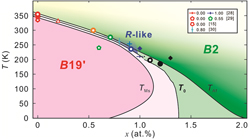Article contents
Transformation entropy change and precursor phenomena in Ni-rich Ti–Ni shape memory alloys
Published online by Cambridge University Press: 25 September 2017
Abstract

Many issues concerning the transformation behaviors in the Ni-rich Ti–Ni system remain unresolved, such as the isothermal nature of the B19′-martensitic and R-phase transformations and the precursor phenomena in the B2-parent phase. To clarify the origins of these behaviors, we investigated the transformation latent heat, specific heat, and superelastic behaviors of several Ni-rich Ti–Ni alloys in terms of the entropy change. An anomalous, very wide hump in the specific heat was detected for the B2-parent phase, which can likely be attributed to the precursor phenomenon in the B2-parent phase. In the critical region where the anomalous hump intersects the B19′-martensitic transformation, some evidences of the R-phase transformation were observed, such as a tweed-like microstructure and a specific heat peak with first-order-transformation characteristics. These findings suggest a strong relationship between the R phase and the precursor state in the B2-parent phase.
- Type
- Invited Paper
- Information
- Copyright
- Copyright © Materials Research Society 2017
Footnotes
Present Address: RIKEN, Center for Emergent Matter Science (CEMS), Wako 351-0198, Japan.
Contributing Editor: Yang-T. Cheng
References
REFERENCES
- 11
- Cited by



